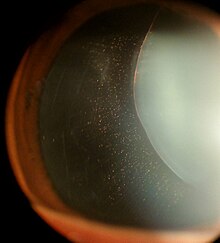
Back متلازمة مارفان Arabic Marfan sindromu AZ مارفان سندروم AZB Marfanov sindrom BS Síndrome de Marfan Catalan کۆنیشانی مارفان CKB Marfanův syndrom Czech Marfans syndrom Danish Marfan-Syndrom German Σύνδρομο Μαρφάν Greek
| Marfan syndrome | |
|---|---|
| Other names | Marfan's syndrome |
 | |
| Ectopia lentis in Marfan syndrome: Zonular fibers are seen. | |
| Specialty | Medical genetics |
| Symptoms | Tall thin build; long arms, legs and fingers; flexible fingers and toes[1] |
| Complications | Scoliosis, mitral valve prolapse, aortic aneurysm[1] |
| Duration | Long term[1] |
| Causes | Genetic (autosomal dominant)[1] |
| Diagnostic method | Ghent criteria[2] and genetic testing (DNA analysis).[3] |
| Differential diagnosis | Loeys–Dietz syndrome, Ehlers–Danlos syndrome |
| Medication | Beta blockers, calcium channel blockers, ACE inhibitors[4][5] |
| Prognosis | Often normal life expectancy[1] |
| Frequency | 1 in 5,000–10,000[4] |
Marfan syndrome (MFS) is a multi-systemic genetic disorder that affects the connective tissue.[6][7][1] Those with the condition tend to be tall and thin, with long arms, legs, fingers, and toes.[1] They also typically have exceptionally flexible joints and abnormally curved spines.[1] The most serious complications involve the heart and aorta, with an increased risk of mitral valve prolapse and aortic aneurysm.[1][8] The lungs, eyes, bones, and the covering of the spinal cord are also commonly affected.[1] The severity of the symptoms is variable.[1]
MFS is caused by a mutation in FBN1, one of the genes that make fibrillin, which results in abnormal connective tissue.[1] It is an autosomal dominant disorder.[1] In about 75% of cases, it is inherited from a parent with the condition, while in about 25% it is a new mutation.[1] Diagnosis is often based on the Ghent criteria,[9] family history and genetic testing (DNA analysis).[2][4][3]
There is no known cure for MFS.[1] Many of those with the disorder have a normal life expectancy with proper treatment.[1] Management often includes the use of beta blockers such as propranolol or atenolol or, if they are not tolerated, calcium channel blockers or ACE inhibitors.[4][5] Surgery may be required to repair the aorta or replace a heart valve.[5] Avoiding strenuous exercise is recommended for those with the condition.[4]
About 1 in 5,000 to 1 in 10,000 people have MFS.[4][10] Rates of the condition are similar in different regions of the world.[10] It is named after French pediatrician Antoine Marfan, who first described it in 1896.[11][12]
- ^ a b c d e f g h i j k l m n o p "What Is Marfan Syndrome?". NHLBI, NIH. October 1, 2010. Archived from the original on 6 May 2016. Retrieved 16 May 2016.
- ^ a b "How Is Marfan Syndrome Diagnosed?". NHLBI, NIH. October 1, 2010. Archived from the original on 27 September 2022. Retrieved 16 May 2016.
- ^ a b Marelli S, Micaglio E, Taurino J, Salvi P, Rurali E, Perrucci GL, Dolci C, Udugampolage NS, Caruso R, Gentilini D, Trifiro' G, Callus E, Frigiola A, De Vincentiis C, Pappone C, Parati G, Pini A (July 2023). "Marfan Syndrome: Enhanced Diagnostic Tools and Follow-up Management Strategies". Diagnostics. 13 (13): 2284. doi:10.3390/diagnostics13132284. PMC 10340634. PMID 37443678.
- ^ a b c d e f "Marfan Syndrome". National Organization for Rare Disorders. 2017. Archived from the original on 12 November 2019. Retrieved 5 November 2016.
- ^ a b c "How Is Marfan Syndrome Treated?". NHLBI, NIH. October 1, 2010. Archived from the original on 11 June 2016. Retrieved 16 May 2016.
- ^ Loeys BL, Dietz HC, Braverman AC, Callewaert BL, De Backer J, Devereux RB, et al. (July 2010). "The revised Ghent nosology for the Marfan syndrome". Journal of Medical Genetics. 47 (7): 476–485. doi:10.1136/jmg.2009.072785. hdl:1854/LU-1013955. PMID 20591885. S2CID 13895128. Archived from the original on 2017-08-29. Retrieved 2016-01-10.
- ^ Nistri S, De Cario R, Sticchi E, Spaziani G, Della Monica M, Giglio S, et al. (September 2021). "Differential Diagnosis between Marfan Syndrome and Loeys-Dietz Syndrome Type 4: A Novel Chromosomal Deletion Covering TGFB2". Genes. 12 (10): 1462. doi:10.3390/genes12101462. PMC 8536070. PMID 34680857.
- ^ "What Are the Signs and Symptoms of Marfan Syndrome?". NHLBI, NIH. October 1, 2010. Archived from the original on 11 June 2016. Retrieved 16 May 2016.
- ^ Loeys BL, Dietz HC, Braverman AC, Callewaert BL, De Backer J, Devereux RB, Hilhorst-Hofstee Y, Jondeau G, Faivre L, Milewicz DM, Pyeritz RE, Sponseller PD, Wordsworth P, De Paepe AM (2010). "The revised Ghent nosology for the Marfan syndrome". Journal of Medical Genetics. 47 (7): 476–485. doi:10.1136/jmg.2009.072785. hdl:1854/LU-1013955.
- ^ a b Keane MG, Pyeritz RE (May 2008). "Medical management of Marfan syndrome". Circulation. 117 (21): 2802–2813. doi:10.1161/CIRCULATIONAHA.107.693523. PMID 18506019.
estimated prevalence of 1 case per 3000 to 5000 individuals
- ^ Marfan, Antoine (1896). "Un cas de déformation congénitale des quartre membres, plus prononcée aux extrémitiés, caractérisée par l'allongement des os avec un certain degré d'amincissement [A case of congenital deformation of the four limbs, more pronounced at the extremities, characterized by elongation of the bones with some degree of thinning]". Bulletins et Mémoires de la Société Médicale des Hôpitaux de Paris (in French). 13 (3rd series): 220–226. OCLC 493643386. NAID 10014879958.
- ^ "Antoine Bernard-Jean Marfan". Whonamedit?. Archived from the original on 8 March 2016. Retrieved 16 May 2016.